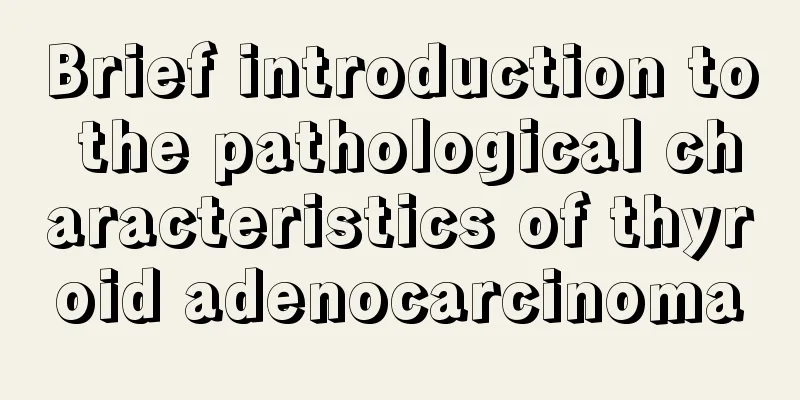Brief introduction to the pathological characteristics of thyroid adenocarcinoma

|
In today's society, as people's pace of life accelerates, many people have irregular lifestyles, abnormal diets, and lack of exercise, which can easily lead to various diseases in the body. Among them, thyroid cancer is a very common disease. Let me introduce the pathological characteristics of thyroid cancer to you. Thyroid cancer is a common malignant tumor, accounting for about 1/3 of primary epithelial thyroid tumors. There are four common pathological features of thyroid cancer: 1. Papillary carcinoma: It is the most common type of thyroid cancer. Macroscopically, the tumor is generally round, about 2-3 cm in diameter, without capsule, hard in texture, and grayish white in cut surface. In some cases, cysts are formed, and nipples can be seen in the cysts, so it is called papillary cystadenocarcinoma. Microscopically, the nipple has many branches, and there is fibrovascular stroma (true papilla) in the center of the nipple. Concentric calcified bodies, i.e. psammoma bodies, are common in the stroma, which are helpful for diagnosis. Papillary carcinoma sometimes appears as a microcancer with a diameter of less than 1 cm, which is clinically called "occult cancer". 2. Follicular carcinoma: generally more malignant than papillary carcinoma and with a worse prognosis. Macroscopically: nodular, with incomplete capsule, relatively clear borders, grayish white cut surface, and soft texture. Microscopically: follicles of varying degrees of differentiation can be seen. A small number of cases are composed of eosinophilic cancer cells, which are called eosinophilic carcinoma. 3. Medullary carcinoma: Also known as C-cell carcinoma, it is a malignant tumor that arises from parafollicular cells (i.e., C cells) and is an AUPD tumor. Macroscopically: single or multiple, with pseudocapsules, about 1-11 cm in diameter, grayish white or yellowish brown in cross section, solid and soft. Microscopically: tumor cells are round or polygonal, spindle-shaped, with round or oval nuclei and inconspicuous nucleoli. Tumor cells are arranged in solid sheet nests or papillary or follicular shapes, and amyloid substances are often deposited in the stroma (possibly related to calcitonin secretion). Electron microscopy: There are neurosecretory granules of relatively uniform size in the cytoplasm. 4. Undifferentiated cancer: also known as anaplastic cancer or sarcomatoid cancer, less common. Macroscopic observation: large mass, irregular lesions, no capsule, extensive infiltration and destruction, gray-white cut surface, often with bleeding and necrosis. Microscopic observation: cancer cells vary in size, shape, and staining depth, with many nuclear divisions. We hope that the above introduction to the pathological characteristics of thyroid cancer will be helpful to patients so that they can receive symptomatic treatment and recover soon. |
<<: What is the cause of benign thyroid cancer?
>>: What is the cause of thyroid cancer?
Recommend
What can I eat to cure hemorrhoids quickly?
Hemorrhoids are a troublesome disease. Once hemor...
Urinalysis results positive for crystals
Urine test is a relatively common experience meth...
Analysis of the strongest carcinogen - aflatoxin
The cause of liver cancer is not only related to ...
What to do if your gums are red, swollen and bleeding? Treat gingivitis in time
The most common cause of red, swollen and bleedin...
What to do if gastric cancer recurs after surgery?
For cancer patients, surgery can only remove canc...
Steps for preparing normal saline solution
Sodium chloride injection is actually normal sali...
How to avoid leg hair
The hair on the body is a natural growth state. F...
Bronchitis dry cough that lasts for a long time
When bronchitis attacks, the patient will have a ...
Which succulents are poisonous
Growing flowers and plants has always been a leis...
Why can't I close my mouth when I yawn?
If the human body does not pay attention to some ...
One longevity point can cure six major diseases
As the saying goes, "For infants, moxibustio...
How to avoid the consequences of failure of perforaminal endoscopic lumbar discectomy?
Perforaminal endoscopic lumbar discectomy is a re...
Nerve block and anti-inflammatory
If people's bodies become inflamed, most of t...
How to make roses into dried flowers
In our lives, many people are particularly happy ...
How to open your throat when singing
Some people like singing very much, but some peop...









